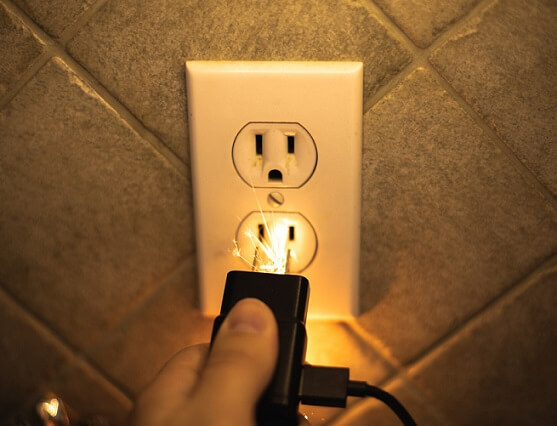What is a “Ground Fault”?
In a properly functioning electrical circuit, current flows from the hot wire to the neutral wire. When the current takes an unintended path through a ground wire, any connected equipment or a person touching the equipment completes the circuit. Ground faults result in a sudden reduction in resistance as the current flows unimpeded to the conductor.
How Does a GFCI Work?
A GFCI (Ground-Fault Circuit Interrupter) shuts off the power in the event of a ground fault within 1/40th of a second of the fault detection. They detect incoming and outgoing current levels and cut off the power when current levels. When the outgoing and returning current differ by more than five milliamperes, the GFCI stops the flow.
Which Rooms of the Home Require GFCIs?
The 2023 version of the National Electrical Code requires GFCIs in all kitchen receptacles, bathrooms, crawl spaces, laundry rooms, and garages. If you have an older property and are reviewing GFCI upgrades, begin with these property areas and any part of the home where electricity might accidentally contact water.
Since 2020, the NEC also required GFCIs for 125-volt to 250-volt receptacles supplied by single-phase branch circuits, rated 150 vaults or less to the ground. This requirement usually impacts clothes dryers and outlets throughout basements.
What is an Arc Fault?
An arc fault occurs when loose or corroded wires cause electrical sparking or arcing, which creates heat in the circuit and can potentially cause electrical fires. Arc faults often happen when construction work damages wiring behind a wall, allowing current to leak from the wire and generate heat.
How Does an AFCI Work?
AFCIs (Arc Fault Circuit Interrupters) continuously monitor current flow and trip the internal contacts to stop power to the circuit and mitigate the risk of electrical fires. While conventional circuit breakers respond to power overloads and short-circuits, AFCIs use electrical waveform analysis to check charge variations, frequencies, and timing to distinguish between everyday arcs that occur due to the operation of switches and plugs and dangerous arcing that can quickly cause fires.
Where are AFCIs Required in the Home?
For new construction, the NEC requires AFCIs in dining rooms, laundry rooms, and all sleeping areas, including bedrooms, living rooms, guest rooms, and dens. The NEC also mandates AFCIs for 5- and 20-ampere branches and 120-volt, single-phase circuits for devices and outlets.
Answers to Common GFCI Vs. AFCI Questions
Can I Install GFCIs or AFCIs Myself?
No. Qualified electricians should install GFCIs and AFCIs. Only licensed electricians should complete home installations involving wiring and connected circuits. Electricians follow specific
safety measures installation and ensure your GFCIs and AFCIs operate safely afterward.
What are the Most Common Causes of GFCI Tripping?
Your GFCI will trip when there’s a quick disconnect in the circuit. You may experience frequent GFCI tripping in the event of:
- Moisture in the area and wet wiring
- Defective appliances
- Improper wiring installation
- Multiple pieces of electrical equipment improperly connected on one circuit, causing an overload
How Common Are Electrical Fires?
While recent innovations in electrical safety and upgrades to the National Electrical Code have reduced the number of fires across the country, data from the Electrical Fire Safety Institute shows there are 51,000 electrical fires across the U.S. each year. The latest data also shows electrical fires cause nearly 500 deaths, more than 1400 injuries, and $1.3 billion in property damage annually.
Custom Electrical Services Set the Standards for Electrical Safety
Protect your older home by installing the latest GFCIs and AFCIs with Custom Electrical Services. We set the standards for Iowa electrical safety, undergo regular training on the newest technology, and offer flexible scheduling to visit your home on short notice in the event of an electrical safety concern. Contact our team today at 515-669-3418 to discuss electrical safety options for your home!



